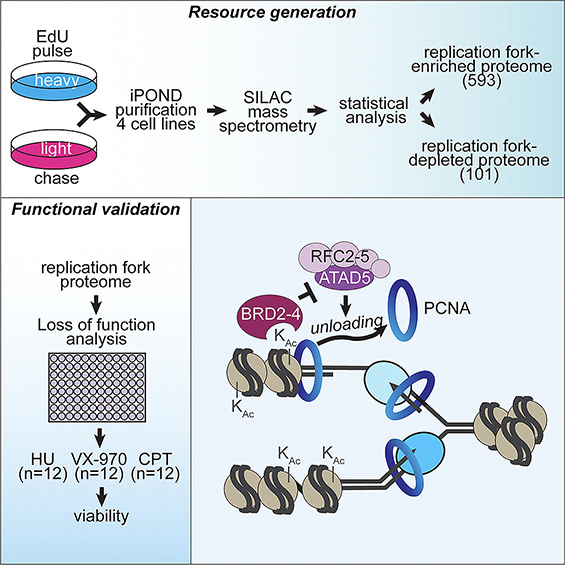Stephen Doster
-

Replicating DNA is a crowded affair
By Lorena Infante Lara DNA replication is an intensely complicated process that relies on the actions and interactions of many, many proteins. At least 593, to be precise. Using iPOND (isolation of proteins on nascent DNA), a tool that was first developed in his lab, David… Read MoreOct. 9, 2019
-

VICC’s Rathmell honored with Louisa Nelson Award
Oct. 3, 2019, 10:09 AM by Tom Wilemon The recipients of the 2019 Louisa Nelson Awards include a poet, a community activist and Vanderbilt cancer researcher Kimryn Rathmell, MD, PhD, Cornelius Abernathy Craig Professor of Medicine. Kimryn Rathmell, MD, PhD Each year, Nelson’s Green… Read MoreOct. 4, 2019
-

Team discovers one more piece to the autism puzzle
Oct. 3, 2019, 10:09 AM by Bill Snyder Mutations in a subunit of a receptor that binds the major inhibitory neurotransmitter GABAA in the brain have been linked, through a common mechanism, to epilepsy, autism and intellectual disability, researchers at Vanderbilt University Medical Center and colleagues report. The team’s discovery,… Read MoreOct. 4, 2019
-

A catalog of DNA replication proteins
Oct. 3, 2019, 10:09 AM by Leigh MacMillan Maintenance of genome integrity — and prevention of diseases such as cancer — requires complete and faithful replication of the genome every cell division cycle. To fully understand how genome integrity is maintained, David Cortez, PhD, and colleagues have… Read MoreOct. 4, 2019
-

Cathy Pettepher to receive AAMC Distinguished Teacher Award
Pettepher to receive AAMC Distinguished Teacher Award Sep. 24, 2019, 4:03 PM Cathy Pettepher, PhD by Kathy Whitney Cathy Pettepher, PhD, professor of Biochemistry and assistant dean for Assessment, Vanderbilt University School of Medicine, is the recipient of the 2019 Alpha Omega Alpha Robert J. Glaser Distinguished Teacher Award from… Read MoreSep. 25, 2019
-

Antibody “road block” enables fine-tuning for cardiac recovery, decreases risk of heart failure
by Spencer Turney Sep. 19, 2019, 9:00 AM More than one million Americans per year experience myocardial infarction, commonly known as a heart attack, as well as the healing and rebuilding phase that begins shortly thereafter – a complicated process which involves remodeling and… Read MoreSep. 24, 2019
-

On-the-move cancer cells prefer a “comfort cruise,” follow predictable paths of least resistance
by Spencer Turney Sep. 13, 2019, 6:00 AM New research from a group of Vanderbilt biomedical engineers reveals that while cancer cells move quickly in metastasis, they’re rather lazy in which paths they choose. According to the researchers, migrating cancer cells decide which path… Read MoreSep. 24, 2019
-

How salt increases blood pressure
Sep. 5, 2019, 10:00 AM by Leigh MacMillan Salt-sensitive hypertension affects about half of people with high blood pressure, but the precise mechanism of how dietary salt contributes to blood pressure elevation, kidney injury and cardiovascular disease remains unclear. Annet Kirabo, DVM, MSc, PhD, and colleagues recently… Read MoreSep. 24, 2019
-

Nancy Carrasco & David Merryman honored with endowed chairs
by Ann Marie Deer Owens Sep. 20, 2019, 8:29 AM (L to r) Rogers Hall, Sandra Simmons, Sean Seymore, Nancy Carrasco, Sarah Igo, Mattias Polborn, Peter Rousseau, David Merryman and Interim Chancellor and Provost Susan R. Wente (Anne Rayner/Vanderbilt University) Vanderbilt’s eight… Read MoreSep. 21, 2019
-

Fred Guengerich, PhD and Elaine Sanders-Bush, PhD, named ASPET Fellows
Guengerich, Sanders-Bush named ASPET fellows Sep. 20, 2019, 11:02 AM by Bill Snyder Vanderbilt University’s F. Peter (Fred) Guengerich, PhD, and Elaine Sanders-Bush, PhD, are among 22 prominent scientists named this week to the inaugural class of Fellows of the American Society for Pharmacology and Experimental Therapeutics (ASPET). In… Read MoreSep. 20, 2019